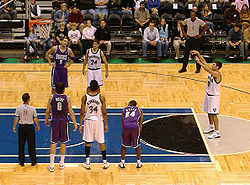
Bonus (basketball)
Encyclopedia

Basketball
Basketball is a team sport in which two teams of five players try to score points by throwing or "shooting" a ball through the top of a basketball hoop while following a set of rules...
, the bonus situation (also called the penalty situation) is a situation where one team accumulates a certain amount of foul
Foul (basketball)
In basketball, a foul is an infraction of the rules concerning illegal personal contact with an opponent and/or unsportsmanlike behavior. A personal foul is the most common type of foul in basketball. Due to the nature of the game, personal fouls occur on occasion and are not always regarded as...
s, which varies depending on the level of play. When the number of fouls has been reached, the bonus begins. If the team that has reached the limit commits another foul after reaching the limit, the fouled player from the opposing team will be entitled to take two free throw
Free throw
In basketball, free throws or foul shots are unopposed attempts to score points from a restricted area on the court , and are generally awarded after a foul on the shooter by the opposing team...
s, even if the foul given was a non-shooting foul. Teams under the limit are commonly referred to as having "fouls to give", meaning they can try to disrupt their opponents with intentional fouls without fear of free throws being assigned.
FIBA rule
Under FIBAInternational Basketball Federation
The International Basketball Federation, more commonly known as FIBA , from its French name Fédération Internationale de Basketball, is an association of national organizations which governs international competition in basketball...
rules, used for all competitions involving international teams and most leagues outside the U.S., the penalty is triggered when a team commits four fouls in a quarter. When a team commits its fifth foul, the opposing team receives two free throws, regardless of whether the foul was a shooting or a non-shooting foul. All personal fouls committed by players count towards the team foul count.
Only defensive fouls are awarded free throws.
All overtime periods are considered a continuation of the fourth quarter for the purpose of foul accumulation.
NBA differences
In the National Basketball AssociationNational Basketball Association
The National Basketball Association is the pre-eminent men's professional basketball league in North America. It consists of thirty franchised member clubs, of which twenty-nine are located in the United States and one in Canada...
, rules on the team foul penalty are similar to the FIBA version, with three major differences:
Only defensive and loose-ball (foul occurs when no team has control of the ball) fouls count towards a team's limit for the team foul penalty. Offensive fouls do not count towards the team foul penalty.
During the last two minutes of each quarter, the team foul penalty applies after a team commits one foul in the final two minutes, if a team did not reach the penalty in the first ten minutes of a period. Free throws begin on the second defensive foul in the final two minutes of the period.
If a game enters overtime
Overtime (sports)
Overtime or extra time is an additional period of play specified under the rules of a sport to bring a game to a decision and avoid declaring the match a tie or draw. In most sports, this extra period is only played if the game is required to have a clear winner, as in single-elimination...
, the foul limit is lowered to three. This is because the NBA's overtime periods are five minutes in length, which is much shorter than the normal 12-minute quarters during regulation time. The opposing team will be awarded one free throw, along with one penalty free throw, if the bonus situation happens in overtime. As is the case in regulation, one foul in the final two minutes automatically puts the team in the team foul penalty.
Use in college basketball
The bonus situation is also used in American college basketballCollege basketball
College basketball most often refers to the USA basketball competitive governance structure established by the National Collegiate Athletic Association . Basketball in the NCAA is divided into three divisions: Division I, Division II and Division III....
, but the rules are much different from the bonus rules of the NBA. The basic bonus rules remain the same, but the limit for team fouls is six in a half. On the seventh foul, the opposing team is awarded at least one free throw, no matter if the foul was shooting or non-shooting. In the case of a non-shooting foul, the opposing player must make the first free throw in order to be awarded a penalty bonus free throw. This is commonly referred to as "one-and-one". (A shooting foul is not subject to this requirement; the player will get all free throw attempts allowed by the rules regardless of the result of the preceding shot.) Beginning with the tenth foul of a half, the fouled team is awarded two free throws on non-shooting fouls regardless of whether or not the first shot is made. For purposes of bonus, overtime in college basketball is considered to be an extension of the second half.
The rules of the National Federation of State High School Associations
National Federation of State High School Associations
The National Federation of State High School Associations is the body that writes the rules of competition for most high school sports and activities in the United States. Most high schools, whether public or private, belong to their state's high school association; in turn, each state association...
(NFHS), which govern high school basketball in the United States, follow the NCAA on this point. Even though the NFHS rules divide the game into quarters, the team foul count resets only at halftime.

